5 Best Microphones for Voice Over Compared 2023 (+ Buyer’s Guide)
Chioma Ezeh is supported by its audience. When you purchase through links on our site, we may earn an affiliate commission at no extra cost to you. As an Amazon Associate, we earn from qualifying purchases. Learn more
Chioma Ezeh is supported by its audience. When you purchase through links on our site, we may earn an affiliate commission at no extra cost to you. As an Amazon Associate, we earn from qualifying purchases. Learn more
Voice overs are an essential part of many audio-visual projects, from radio and TV shows to YouTube videos, podcasts, and audiobook narration.
But in order for a voice-over to sound its best, you need the right equipment.
The most important piece of this equipment is the microphone.
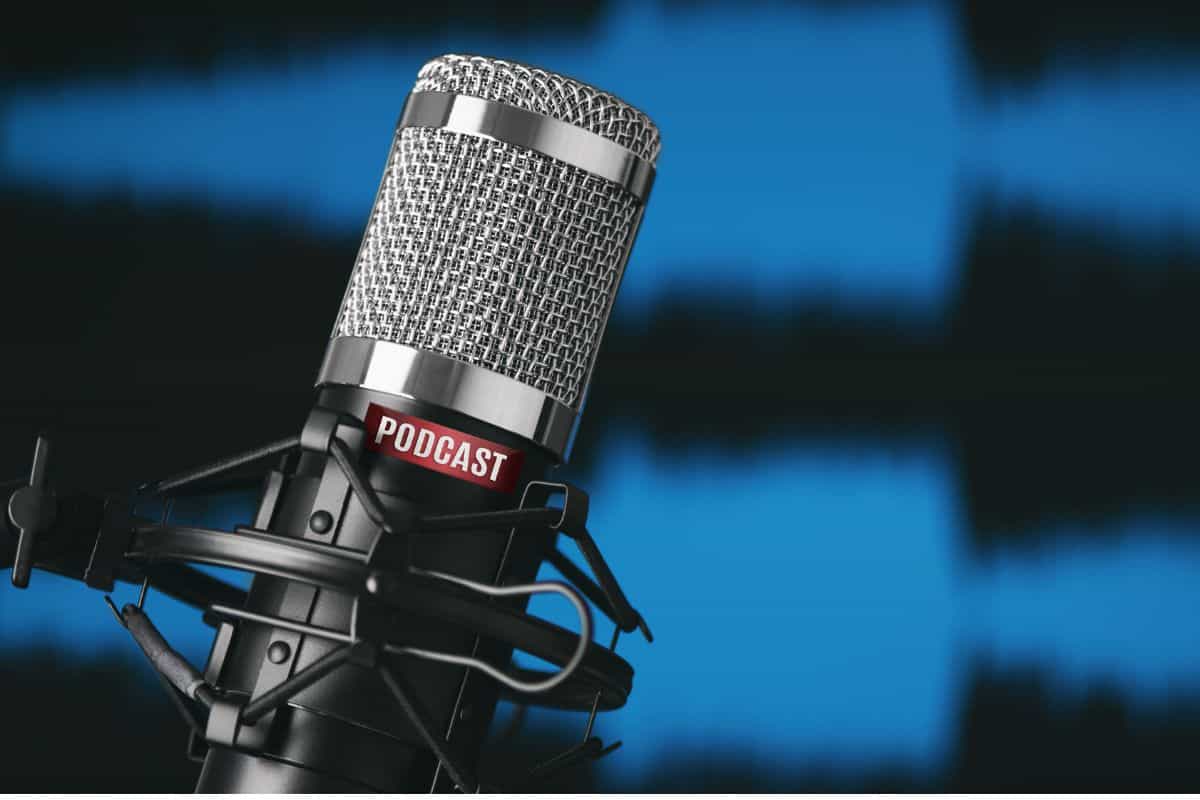
Having the right microphone can make all the difference between a professional-sounding voiceover and one that sounds amateurish or distorted.
It can provide an excellent sound quality that is great for stage performance, audiobook recording, or use with a home theater.
To help you choose the perfect mic for your needs, I’ve tested five of the best microphones for voiceovers available on the market in 2023, along with a handy buyer’s guide (read till the end) so you know exactly what to look out for when shopping around.
So, ready to learn all these and more?
Let’s get started.

Let’s Talk
Are you a writer aspiring to pen a masterpiece that never fails to captivate? Look no further. Reach out to us and uncover how we can help you to take your writing to unprecedented heights!

What is A Voice Over microphone?
What is A Voice Over microphone?
A Voice Over microphone is a specialized microphone designed for voice recordings. It usually has an omnidirectional or cardioid pickup pattern, which allows it to capture the full range of sound from your voice without picking up too much background noise.
Voice Over microphones is commonly used in recording studios and in radio/television broadcasting. They can also be used for podcasting, audiobook recordings, voice-over work, and other audio applications.
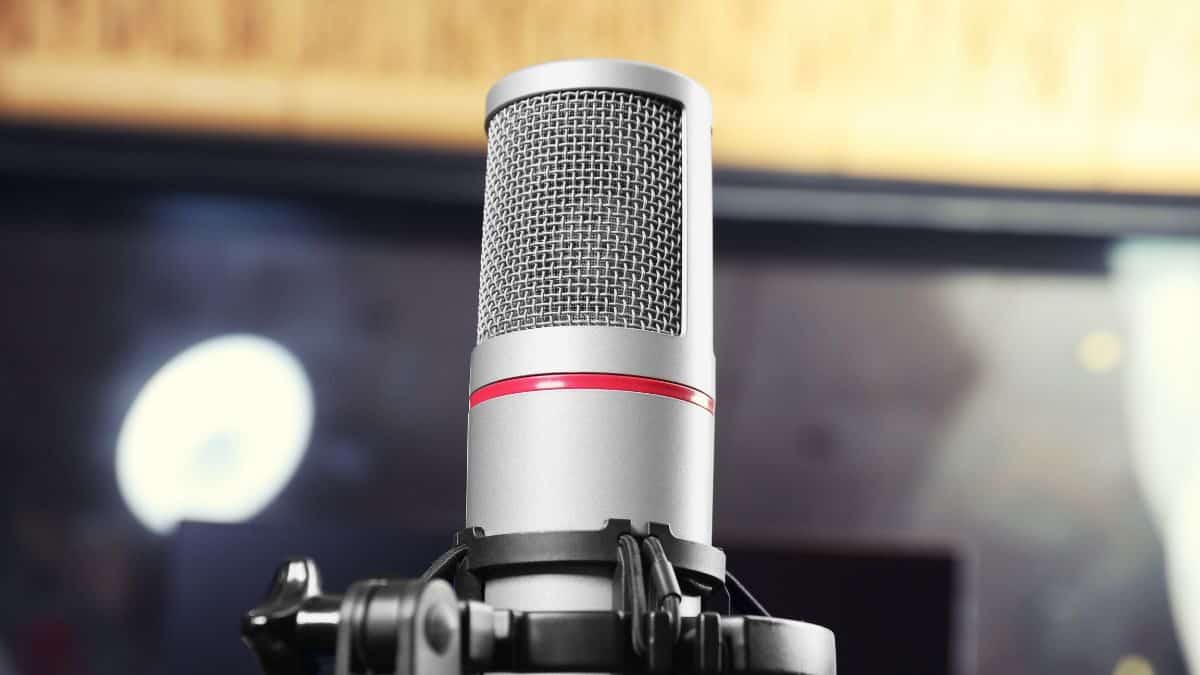
What is A Voice Over microphone?
A Voice Over microphone is a specialized microphone designed for voice recordings. It usually has an omnidirectional or cardioid pickup pattern, which allows it to capture the full range of sound from your voice without picking up too much background noise.

Voice Over microphones is commonly used in recording studios and in radio/television broadcasting. They can also be used for podcasting, audiobook recordings, voice-over work, and other audio applications.
Buying a quality mic for voice acting can earn remarkable performances for you.
You may even aim for Rick’s voice in Rick and Morty, or Goku’s voice in Dragon Ball Z. About 25% of buyers pick a microphone by trial and error.
It’s essential to consider your budget and the sound you want to create. Your recording space plays an important role too.
Voice actors can now buy good-quality mics at low prices. And it is because of improvements and remote recording.
What Is the Best Microphone for Voice Over?
The best microphone for voice-over depends on the type of project you are working on. If you’re doing a professional narration or commercial, it’s typically better to invest in a higher-quality condenser microphone like a Shure SM7B, or Neumann U87Ai.
If you are doing simpler projects like podcasting or amateur voiceover, then an affordable dynamic microphone like the Audio-Technica ATR 2100 can provide great sound.
Best Microphones For Voice-Over – Overview
- Fifine K669B USB: Best Overall
- Neumann TLM 103: Best Natural Sound
- Rode NT-USB: Best USB Microphone
- Blue Yeti: Best Condenser Microphone
- Neumann U87: Best Professional Mics
Best Microphones For Voice-Over – Overview
- Fifine K669B USB: Best Overall
- Neumann TLM 103: Best Natural Sound
- Rode NT-USB: Best USB Microphone
- Blue Yeti: Best Condenser Microphone
- Neumann U87: Best Professional Mics
It is also equally important to consider the environment in which you will be recording, as some microphones are better suited for certain environments than others.
5+ Best Microphones for Voice Over
1. Fifine K669B USB: Best Overall
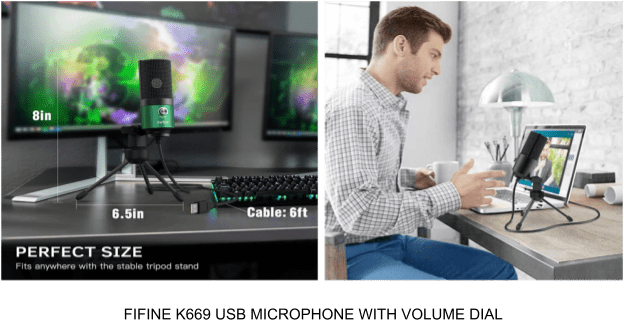
People seeking a high-quality microphone for voice-over recording will love the Fifine K669B-USB Mic.
This is unarguably the best microphone for voice over.
The Fifine K669B offers clear and accurate sound. Also, it carries a built-in shock mount and a pop filter, decreasing extraneous noise.
This feature keeps your recordings clean and distraction-free.
The Fifine K669B is simple to set up and use, making it an excellent choice for both amateurs and experts.
Highlights:
- Users enjoy a pleasant and smooth sound, ideal for character voices and narration
- The microphone is incredibly sensitive, catching even the most inaudible sounds.
- The Fifine K669B USB mic includes a built-in pop filter, meaning plosives will not diminish your recording quality
- The microphone I simple to use because of its plug-and-play nature
- They include a desktop stand with a microphone. This allows you to set the microphone precisely where you want it. This feature ensures high-quality sound
My experience:
The Fifine K669B offers clear sound with excellent bass. It also sounds fantastic when I don’t adjust the audio recording with microphone settings.
The stand is all plastic, which is a bit of a turn off. Although it does the job, I will recommend having a boom arm or a shock mount.
Aside from that, the microphone is entirely metal and feels really pleasant to the touch.
Pricing:
The Fifine K669B USB Microphone sells on Amazon with various pricing options like $26.35, $27.11, $27.99, $29.99, and $30.99, respectively.
What I like about Fifine K669B:
- It accurately takes in all the details by canceling out any noise and undesirable sound. It offers clear, crisp, and high-quality audio
- I record on the go because the size is small enough to easily fit in a side pocket of my backpack
Bottom line:
The Fifine K669B USB mic is a high-quality and low-cost choice for YouTubers, streamers, and other video makers.
This microphone has excellent sound quality, which makes it ideal for recording and streaming.
The Fifine K669B also boasts a sleek and attractive design, making it a good quality pick.
2: Neumann TLM 103: Best Natural Sound
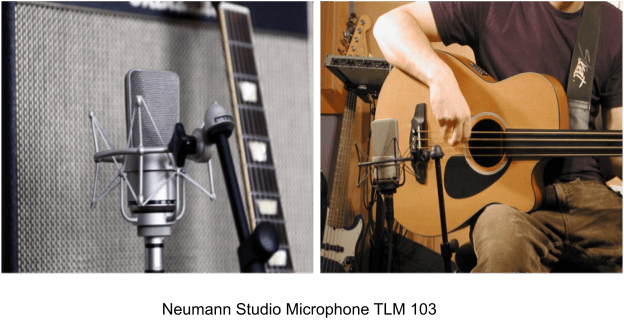
The Neumann TLM 103 microphone is one of the best microphones for voice-over.
It captures the natural tone of your voice and has a broad frequency response.
It is ideal for a noisy environment because the cardioid pattern reduces any undesirable sound.
The TLM 103 is perfect for high-speed devices such as desktop fans or air conditioning units because it removes harsh and popping sounds.
The TLM 103 is a fantastic choice for voice-over recording because of its precise sound performance and adaptability in various applications.
Highlights:
- Users enjoy natural sound, making it ideal for capturing even minor details of the human voice
- The TLM 103 has good off-axis rejection. This feature means that the background noise is unlikely to be an issue when recording
- It’s long-lasting, so you can count on it for many years.
My experience:
I use the Neumann TLM 103 primarily for voice recordings. It truly shines in that capacity.
I love this model because it is too good to be true for minimizing harsh sounds.
However, simply positioning myself slightly off-axis from the microphone eliminates most of the harsh sounds.
It’s also important to note that this condenser microphone requires a compatible room or, at the very least, some form of reflection filter.
Otherwise, the TLM-103 will not provide the best quality.
Pricing:
You can buy a Neumann TLM 103 microphone for $1,495 on Sweetwater, making it the more expensive choice. But overall, it offers the best bang for your buck.
What I like about Neumann TLM 103:
- It offers an authoritative sound. In various situations, the TLM 103 gives me clear sound
- It exhibits remarkably the least self-noise in comparison to other microphones on the market, including the U87, making it ideal for any recording I set up. There will be absolutely no hiss
Bottom line:
This Neumann TLM 103 is a comprehensive microphone that provides excellent value for money.
It produces a crisp, focused sound with very little self-noise.
Professional voice-over artists should consider the Neumann TLM 103.
This microphone is also a fantastic choice for personal studio recording hobbyists looking for a low-cost alternative.
The Neumann TLM 103 is an excellent all-purpose mic that will benefit any musician, podcaster, or voice actor.
3. Rode NT-USB: Best USB Microphone
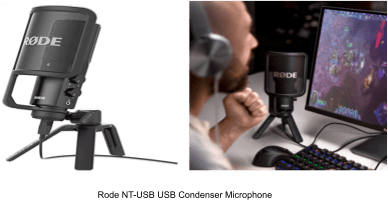
The Rode NT USB microphone is excellent for recording high-quality voice-overs.
The microphone perfectly captures accurate and precise sound. It also includes a pop filter to decrease undesirable noise.
A USB connection makes it simple to connect to any computer.
And the accompanying stand keeps the microphone in a good position for a longer period of time. The Rode NT USB mic is a superb choice for creating high-quality recordings.
Highlights:
- The mic can pick a wide range of audible sounds, perfect for catching all low and high sound variations in a recording
- The directional pattern of the microphone isolates the user’s voice from background noise, which is critical for producing clean recordings
- The mic is relatively simple to set up and use due to its plug-and-play nature
My experience:
In my opinion, the Rode NT USB is more expensive than the competitors, but the audio quality is worth the cost.
But, in terms of sound quality, it competes better with a professional XLR mic.
The USB-C interface makes it much more adaptable while working on a phone or a computer.
It’s worth mentioning that the Rode NT-USB Mini sounds fantastic for gaming, voice-overs, and podcasting.
Pricing:
The Rode NT-USB is among the best USB microphones, outperforming anything under $200. The Rode NT USB mic costs $169.99 at Best Buy, categorizing it as a more expensive microphone.
What I like about Rode NT-USB:
- It is suitable for a wide range of audible sounds
- It helps me monitor my voiceover performances with professional audio equipment. There is no delay in my voice
Bottom line:
The Rode NT USB mic is a good choice for a high-quality voice-over microphone.
This mic is best for podcasters, sound designers, vocalists, and YouTubers.
The Rode NT-USB is suitable for clean audio recording without an extra preamp because of the USB.
So, I’d recommend it for short home studio work or demo recording.
It will satisfy even challenging clients due to its exceptional sound quality, convenient use, and low pricing.
4: Blue Yeti: Best Condenser Microphone
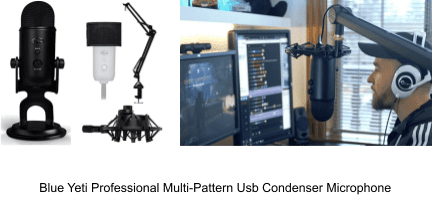
The Blue Yeti USB condenser microphone guarantees top sound quality.
Also, it offers various pattern options, such as cardioid, omnidirectional, bidirectional, and stereo.
Buyers can’t go wrong with this gem.
You can purchase this ultra-high-quality USB microphone for a little more than a hundred dollars.
The Blue Yeti has four recording settings and a very clear sound.
That’s a pretty high value for the price.
It is especially the best option for amateurs who aren’t willing or able to set up a professional studio.
And rich features with great design make it a great choice for experts.
Highlights:
- It captures even the slightest disturbance with three highly sensitive internal condenser capsules, resulting in a very clear and detailed sound
- The four polar patterns help microphone locate the areas to record the sound
- You can disable your monitoring software with the Yeti. It gives you room to appreciate hearing your voice or instrument in real-time
My experience:
The Blue Yeti microphone is famous for podcasts because of its ease of use and low cost.
It assures great results during recording by you or a roundtable conversation.
Yet, I find the Blue Yeti ideal for travel.
The Blue Yeti microphone is a small price to pay for top quality and simplicity. It maintains its title in the recording world of continuous innovations, even after years in the game.
Pricing:
The regular Blue Yeti microphone costs $129.99, which is reasonable for a great-quality microphone. It is even more profound when you consider the high-end models with costs above $1,000. Even the Yeti Pro as the most expensive option offers a reasonable buying price of $249.99.
What I like about Blue Yeti:
- It is affordable on almost any budget while offering high quality, making it the best value for your investment
- The Blue Yeti is highly portable. So, it is ideal for travel, especially recording interviews outside the studio with my mobile workstation. Or I can simply attach it to a tablet via an adapter to record voice
Bottom line:
The Blue Yeti is a brilliant option for podcasters and YouTubers because the plug-and-play feature makes any recording feel like a breeze. This microphone is also ideal for voice-over performers who need to record brief demos in the studio or on location. The mic is suitable for any desktop, making it an excellent choice for studio set designers. And you can easily adjust the sensitivity of the Blue Yeti according to your preferences.
5. Neumann U87: Best Professional Mics
Source: Sound Pure
Professionals have been singing the praises of the standard Neumann U87 mic since its debut in 1967.
Numerous studio albums, including Michael Jackson’s Thriller, use the model for success.
This incredibly expensive microphone has three directional patterns: all-directional, cardioid, and figure-8.
It meets the needs of broadcasters as well as home studio owners alike. Users find this mic to be super sensitive, and it portrays emotions quite well.
Highlights:
- The U87’s depth and strength not only help lower tones reach their full potential but also shine brightly on the upper end
- The Neumann U87 allows users to instantly select three basic polar patterns: figure-eight, cardioid, or Omni. This allows for solo, group, and ambient recordings
- The U87 also contains a switchable roll-off for the human voice. It means that it eliminates sound distortion while focusing more on lower registers to offer more character, tone, and impact
Why should you use voice-over microphones?
So if you’re creating digital media, investing in a reliable voice-over microphone may be just what you need to stand out from the crowd.
You should use voice-over microphones because they are essential for capturing high-quality audio for podcasts, videos, and other digital media. They provide a crisp sound that can be heard clearly and accurately, even in noisy environments.
Voice-over microphones also allow you to customize your audio with features such as compression and equalization to create the perfect sound. In addition, a great microphone can help reduce background noise and unwanted reverb, so your recording sounds professional.
Below are 7 reasons to use a voice-over microphone over studio mics:
1. They capture better performance with natural and audible sound:
Voice-over microphones are designed to pick up sound in a more accurate and efficient manner.
They provide a natural and audible sound that is suitable for voice-over recordings, making them an ideal choice for the recording of professional dialogue.
2. Voice-over microphones offer superior noise rejection:
One of the biggest advantages of using a voice-over microphone is its ability to reject background noise.
Most voice-over microphones have a built-in directional polar pattern, which allows them to capture sound in one direction while rejecting sound from other directions.
This makes it easier to focus on the spoken words and avoid interference from external sources such as traffic noise or air conditioning systems.
3. They offer clear audio by limiting repetitions:
Voice-over microphones are designed to limit the number of repetitions in your recording space, resulting in a clearer and more accurate sound.
This helps eliminate any unnecessary noise or distractions that could be heard through regular mics, resulting in a better overall quality of audio.
4. Voice-over microphones are easy to set up:
Setting up voice-over microphones doesn’t require any special knowledge or equipment.
They come with their own stands, making it easy to position the mic in the right spot for optimal sound capture.
This eliminates any guesswork and ensures that you get professional-quality audio every time.
5. Voice-over microphones help save time:
With a voice-over microphone, you don’t have to worry about running back and forth between recording sessions.
You can easily set up the mic in one spot, record your voiceover, and move on to the next task. This helps you save time and makes recording a breeze.
6. Voice actors enjoy pure audio even in loud atmospheres:
Voice-over microphones are designed to capture audio from a single source, allowing voice actors to enjoy pure and clear recordings even in noisy environments. This makes it easier to deliver the best performance without having to worry about external noise interfering with their recording.
7. Your vocal cords quality Stays Consistent:
Voice-over microphones capture a wide range of sound frequencies, so your vocal cords don’t diminish in quality when you speak for longer periods of time. This ensures that your voice remains consistent and clear no matter how long the recording session is.
Overall, voice-over microphones are an essential tool for any audio enthusiast or professional. They provide superior sound quality and noise rejection, making them perfect for recording
How to choose the best microphone for voice-over recording?
Buyers will find it valuable to explore the key qualities below before buying a specific mic. Most buyers will prefer to choose a voice-over microphone depending on one or more of five factors. These factors include:
- Connection type: XLR microphones to USB mics because they have higher sound quality for the price and are more adaptable.
- Microphone type: Studio voice actors prefer condenser microphones over dynamic mics because they pick quiet sounds.
- Diaphragm size: Most people use large diaphragm mics because of the high-quality signal with low noise.
- Polar patterns: Users consider polar patterns to pick mics that will record audio from the direction they prefer.
- Frequency range: A good microphone has an ideal frequency range. An ideal frequency will range from 80 Hertz to 15,000 Hertz. It means users can hear sounds with ease in this range
Let’s delve deeper into these qualities below.
1. Deciding On connection type: (USB or XLR) for Voice Over recording
A USB microphone is a microphone that you can use without any extra equipment. It’s easy to use and doesn’t cost a lot. An XLR microphone is more versatile, but you need extra equipment like an audio interface and an XLR cable.
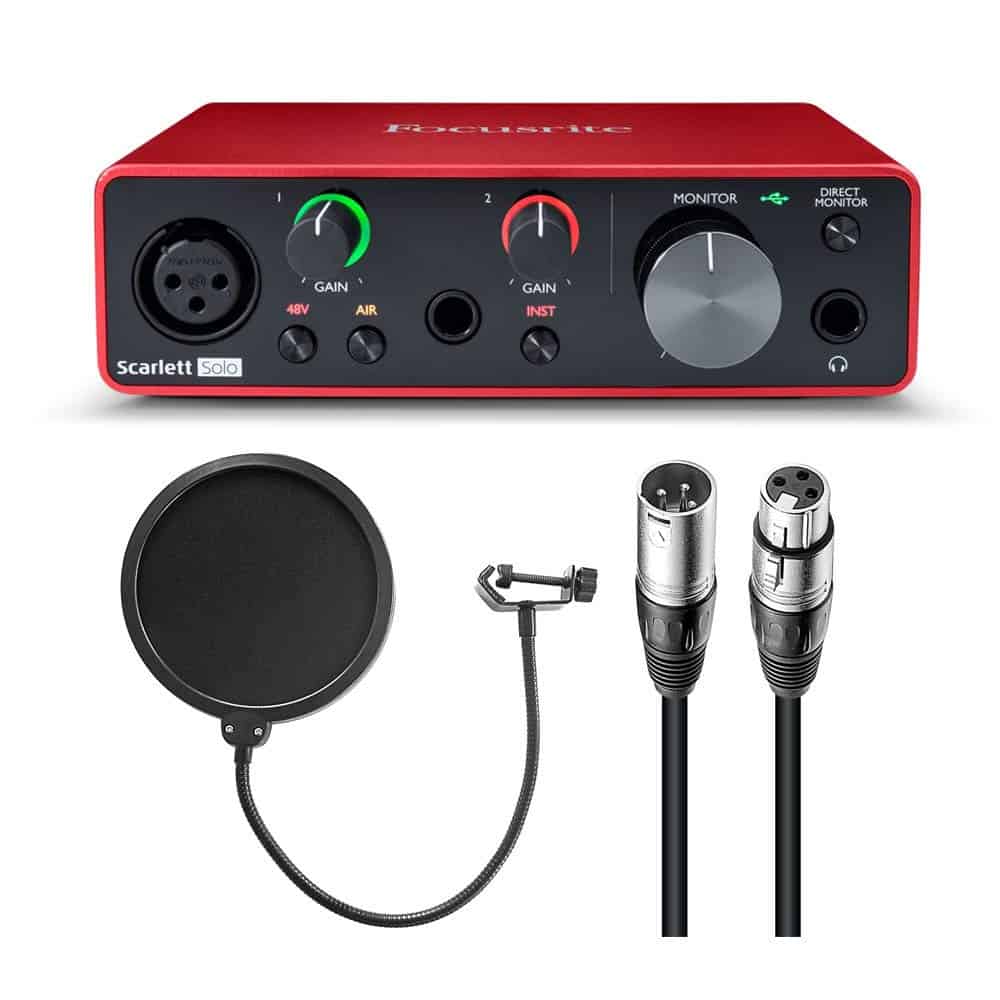
XLR microphones are usually better than USB microphones because they have more features and offer better sound quality for the price.
USB Vs XLR [Pros And Cons]
| USB Microphones | XLR Microphones | |
| Pros | – They are easy to set up. – A typical USB microphone package includes free stand, windsock, shock absorber, and pop filter which reduces the overall cost – Users enjoy an all-in-one compact solution which means they are easy to carry. | – XLR mics offer higher audio quality because they record more information about the sound, therefore much more accurate representation. – They are compatible with other devices like laptops and phones |
| Cons | – Users can’t upgrade each component independently | – They require extra equipment to offer the best results. – Extras make it more time-consuming. – Users setup with additional cords on the recording desk |
My Experience:
USB and XLR microphones offer different values to users depending on the situation.
USB mics are easy to use. You simply plug the mic into your computer, and that’s it. So, I prefer USB mics for online meetings, gaming, and streaming. The USB microphones come with routing software, which voice actors can use in these cases. They even have a special mute button.
I aim for flexibility in my professional recording. So, I prefer XLR microphones for professional work, including voice-over work. And I run it with an audio interface to improve sound quality. At the same time, I can adjust XLR for various applications.
Pricing of USB Vs XLR microphones:
Most people prefer XLR mics to USB microphones because they match buyer needs more and offer a higher quality sound for the price.
People can buy USB mics that cost around $100, such as the Blue Yeti Nano ($93) or the Neat Bumblebee II ($100). Whereas XLR microphones cost an average of $300. Users buy SM7B and Blue Baby Bottle for $359 and $293.
What I like/Dislike about the USB Vs XLR microphones:
| USB Microphones | XLR Microphones | |
| Likes | – They offer an excellent plug-and-play solution. – USB mics are pretty simple to set up. | – I find these mics practical for recording. – They are easier to upgrade. |
| Dislikes | – The interface cannot improve. – I experience glitches in software or drivers at times. | – They require using an audio interface to improve the sound. – I find these harder to set up. |
Best For:
USB mics are best for:
- Lectures, non-commercial podcasts
- Lightweight traveling with your laptop
XLR mics are best for:
- Professional and home studios
- Expos presentations, on-stage, hosting events
2. Deciding On microphone type: (Dynamic or Condenser) for voice over
A dynamic microphone is better at capturing loud sounds, like vocals. With this unique quality, they work well in live settings. These mics don’t need external power, but condenser microphones do.
Condenser mics are better at picking up quiet sounds. They do it best in the studio setting, especially for voiceovers. Moreover, users view these microphones as a more flexible recording choice. They can record any instrument with excellent results.
Both dynamic and condenser microphones are useful for different reasons.

Dynamic Vs Condenser Mics [Pros and Cons]
| Dynamic | Condenser | |
| Pros | – These mics are less sensitive, which means they isolate the voice. So, they work fine in loud rooms – They offer good sound quality in all microphone performance areas | – Users enjoy a quality performance in studio environments because they pick sounds with small differences – These microphones also capture high-frequency sounds like whistles and screams |
| Cons | – Users experience a narrow dynamic range, which means they will produce uncomfortable loud audio in specific situations – They produce low-quality sound while speaking near the mic, especially when working with multiple instruments or moments | – Users need to take special care while working in an environment with background noise. – The mics have fragile material. Moisture and dust can cause harm to the material |
My experience:
I use the condenser microphone to pick more detail, especially in voice-over sessions. During these sessions, I stand away from the desk in my vocal booth.
Other times, I just sit beside my desk. And I don’t wish to be in an ideal position to capture speech. Here, I find a dynamic mic performing well with less noise.
Pricing of Dynamic & Condenser microphones:
Dynamic microphones are less expensive than condenser microphones. A typical dynamic microphone costs from $100 to $400. The Shure SM7B at $359.00 is a suitable example.
But, condenser microphones can cost between $700 and $1,000. Many studios buy the famous Neumann U87 condenser microphone for $3,295. A Rode NT1-A condenser mic offers quality sound for home recording at $199.
What I like/Dislike About The Dynamic or Condenser microphones:
| Dynamic Microphones | Condenser Microphones | |
| Likes | – I don’t need to plug in any external power. – These mics eliminate background noise in loud environments, ensuring clean sounds. | – I can position condenser mics ideally and adjust any input settings to enjoy the finest sound. – They are compatible with almost all sounds in any environment. |
| Dislikes | – I get low-quality sound with improper sensitivity settings because of buzzing background noise. – They are not suitable for recording high-frequency sounds like a child’s voice and glass breaking. | – These microphones reduce sound quality at a maximum signal level. – They suffer under high temperatures and humidity. |
Best for:
For dynamic mics:
- Podcasts, music, voice-over
- Audio amplifiers
- Studios with many sound sources
- Home recording studios
For condenser mics:
- Recording studios, on stage, and in broadcasting
- Multiple studio applications because of accuracy and detail
3. Deciding On diaphragm size (large or small)
Most people use large diaphragm mics because of their high sound quality and low noise.
Condenser microphones with large diaphragms offer pleasing audio. A large diaphragm mic makes you want to sing because it sounds just like you. Vocalists especially appreciate the diaphragm size. Why? It offers them something more to focus on without an audience. In short, users enjoy not only quality sound, but a bright, “bigger than life” audio image.
Small diaphragm microphones are your best bet for clean sound with no extra flavor. People use quality small diaphragm mics for everything because of their neutral tone. What’s more? Small diaphragm mics can pick up low-frequency sounds and record bass instruments.
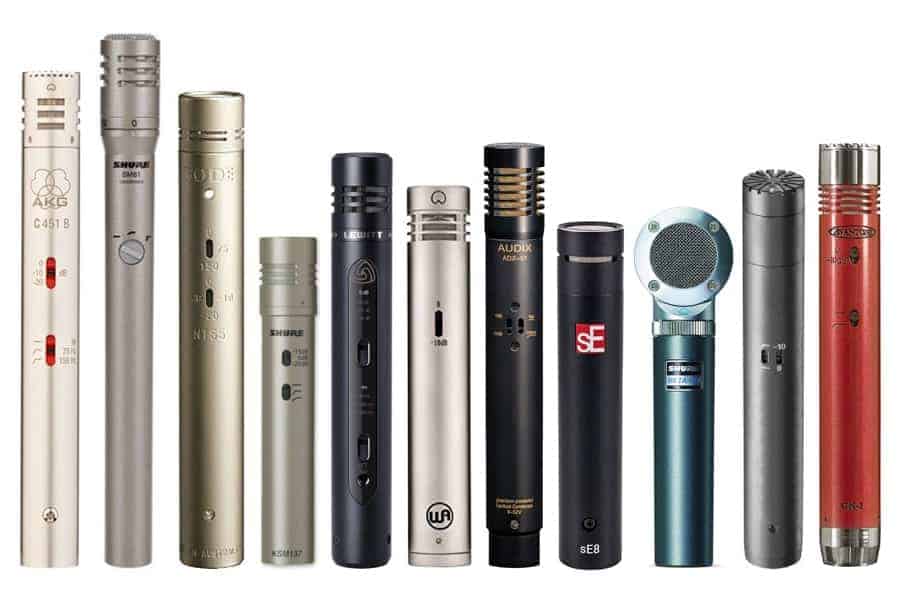
Large Vs Small Diaphragm Mics [Pros and Cons]
| Large Diaphragm | Small Diaphragm | |
| Pros | – They capture all audible audio, including low-frequency sounds like thunder, or a man’s deep voice. – Users enjoy a more comprehensive dynamic range, which means that these mics capture all soft and loud sounds. | – Users carry these mics with ease because of better portability. . These mics capture high quality loud sounds |
| Cons | – They are difficult to carry because of poor portability. – Users suffer from fast wear and tear because of fragile material. – These microphones distort loud sounds while speaking closer to the mic. | – Users find it challenging to record quiet sounds because of low sensitivity. – They are less responsive to high-frequency sounds like screams. |
My Experience
Small diaphragm mics capture brightness well. In contrast, a large diaphragm captures warmth well.
I use small diaphragm mics to produce a colorless, neutral, and detailed sound. So, small diaphragm mics act as realists for me.
I use large diaphragm condensers to make a more engaging sound. So, large-diaphragm mics are romantic to me. I enjoy using a large diaphragm microphone to record with no audience.
Pricing:
LDCs are more expensive than SDCs. For example, the AKG C 451 B sounds excellent on most sound sources. Users can buy this model for $639. If you want a small diaphragm, you can get one for under $200. You can buy the Rode M5 for $149.95.
What I like/Dislike About The Small/Large Diaphragm microphones
| Large Diaphragm Microphones | Small Diaphragm Microphones | |
| Likes | I enjoy the broader range of audible sounds these mics offer They ensure sound quality by removing all noise | They capture sudden sound changes (e.g. hand claps) with a fast and clean response I enjoy quality audio because of consistent sounds in the working environment |
| Dislikes | I need to be careful with high noise or loud instruments because of more sensitivity | These mics capture more background noise due to the physical design |
Best for:
Small diaphragms are best for:
- Voice-over, presentations, live events, interviews, etc.
Large diaphragms are best for:
- Studio use, voice-overs, audiobooks, podcasts, etc
4. Deciding On polar pattern
The omnidirectional pattern captures sound in every direction of a microphone. The bidirectional pattern picks up sound from the front and back of the mic. Also, it rejects sound from both sides.
A cardioid polar pattern captures sound from the microphone’s front. It reduces sound from the back. A sub-cardioid pattern is more suited to capturing a sound source that moves around while remaining in front of the microphone.
Shotgun microphones are long and narrow devices that point straight at a sound from a distance.

Polar Pattern: Omnidirectional Vs Bidirectional Mics [Pros and Cons]
| Omnidirectional Mics | Bidirectional Mics | Cardioid mics | Sub-cardioid mics | Shotgun mics | |
| Pros | – They capture multiple sounds or instruments from different individuals at the same time | – Users can record two sound sources side by side | – These microphones reduce sounds that users don’t desire | – Users enjoy rich sound because these microphones isolate desirable sound from noise | – A shotgun mic gives users more control over the sound because they can mount it directly to the camera |
| Cons | – Users get low-quality sound in a noisy environment | – These microphones don’t digest loud sounds because they capture from the back side too | – Users get bad performance in windy environments | – Users receive sounds in the audio recording that they don’t need | – They are unable to catch enough audio for subjects far away |
My Experience:
In my experience, a mic with a directional pattern helps make sure I record every word with clarity. The improper mic pattern can make half the recording appear faint.
I use a unidirectional microphone most of the time. And both omnidirectional or bidirectional patterns work fine for me in many situations. But several modern microphones are multidirectional by nature. Also, most mics switch between patterns with ease.
Pricing
The most expensive microphone is the Omni pattern. The Shure SM63 microphone is an excellent example of an omnidirectional microphone that provides superior sound and performance at a reasonable price ($149).
- R-121 carries a bidirectional polar pattern and sells for $1,499.
- Users can buy a single cardioid microphone such as Elgato Wave 3 at $149.99.
- With a consistent sub-cardioid, the AT808G sells at $159.
- The Schoeps CMIT 5U, a top-quality shotgun microphone, costs $2,399.
What I like/Dislike About Polar Pattern Microphones
| Omnidirectional Microphones | Bidirectional Microphones | Cardioid microphones | Sub-cardioid microphones | Shotgun microphones | |
| Likes | They capture precise details with no variation from original sound | These mics eliminate any sound coming from the side | They isolate any noisy sounds you don’t want | They offer dry recording excellent for mixing effects in post-production | I can focus on one area with no noise and high-quality audio |
| Dislikes | You will need superb room acoustics | They cause prominent hindrances to sound quality | These mics don’t perform well in aggressive environments | They may lead to unnecessary expenditure because these mics need an in-ear monitor in some situations | They don’t work well at all in small rooms or in spaces with high echoes |
Best for:
| Omnidirectional Microphones | Bidirectional Microphones | Cardioid microphones | Sub-cardioid microphones | Shotgun microphones | |
| Best For | – Choirs – Orchestras – Stage productions | – Broadcast – Podcast – Stereo recording | – Live performances – Studio vocal recordings | – Recording rooms – Close-micing snare drums | – Film – TV sets recordings |
5. Making sense of frequency response
The frequency response of a microphone is crucial for understanding the audible sound range. A mic with a 20 Hertz and 20 Kilohertz range can reproduce every audible sound.
A graph is by far the easiest method for conveying microphone frequency response.
For example, Shure Beta 52A specifies its audible frequency range as 20 Hertz – 10,000 Hertz.

As you can see, the graph offers valuable data that a “20 Hz – 10,000 Hz” range alone cannot.
Microphone Frequency Response for the voice-over
Users must record voice-overs alone in soundproof booths. The acoustic environments have little room sound. And it’s easy to place the microphone in the best location. A flat-frequency response microphone is ideal for recording a human voice. The term “flat frequency” means that your voice-over recording will pick up even the quietest sound.
The legendary Neumann U87 is a typical voice-over microphone with optimal frequency response used in pro studios worldwide.
Many polar patterns work well for voice-overs within isolation booths. Still, people use a cardioid polar pattern more. An audible frequency range reduces the voice-over harshness. This is especially useful in digital recording, which can be too clean in certain instances.
Resources
- https://www.electronicshub.org/xlr-vs-usb/
- https://www.reviewgeek.com/74359/should-you-buy-a-usb-or-xlr-microphone/
- https://www.shure.com/en-US/products/microphones/sm7b?variant=SM7B
- https://www.neumann.com/homestudio/en/difference-between-large-and-small-diaphragm-microphones
- https://www.akg.com/Microphones/CondenserMicrophones/C451B.html?dwvar_C451B_color=Nickel-GLOBAL-Current
- https://www.sweetwater.com/store/detail/SM63–shure-sm63-handheld-omnidirectional-microphone
- https://www.bluemic.com/en-us/products/yeti/
- https://www.soundpure.com/a/expert-advice/recording/voiceover-ldc-mic-shootout/
